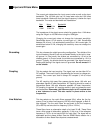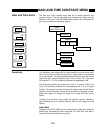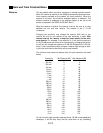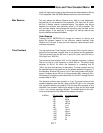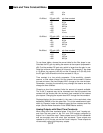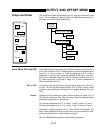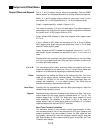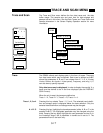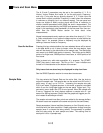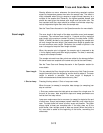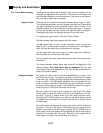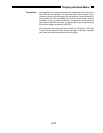
5-16
Output and Offset Menu
Output Offset and Expand The X, Y and R outputs may be offset and expanded. See the SR850
Basics section for a complete discussion of scaling, offsets and expands.
Briefly, X, Y and R analog outputs (either the rear panel X and Y or the
front panel CH1 or CH2 proportional to X, Y or R) are determined by
Output = (signal/sensitivity - offset) x Expand x 10 V
The output is normally 10 V for a full scale signal. The offset subtracts a
percentage of full scale from the output. Expand multiplies the remainder
by a factor from 1 to 256 (output limited to 10 V).
Output offsets ARE reflected in data trace displays which depend upon
X, Y or R.
X and Y offsets do NOT affect the calculation of R or θ. X and Y offsets
WILL affect a polar graph since a polar graph plots X and Y. The R offset
does NOT affect a polar graph.
Output expands do NOT increase the displayed values of X, Y or R in
data traces. Expand increases the resolution of the X, Y or R value in a
trace.
Displays which are showing a trace which is affected by a non-zero offset
or a non-unity expand have their Offst and Expd indicators turned on (at
the lower left of each display).
X, Y or R This key selects which output quantity's offset and expand will be dis-
played and adjusted in this menu box. Only X, Y and R have offsets and
expands. θ can be offset by adjusting the reference phase shift.
Offset Pressing this key selects the Offset as the active entry field. This is the
offset of the output quantity selected above. The offset ranges from
-105.00% to 105.00% of full scale. This offset percentage does not
change with sensitivity - it is an output function. The offset may be
entered numerically or adjusted with the knob.
Auto Offset Pressing this key automatically sets the offset percentage to offset the
selected output quantity to zero.
Expand Pressing this key selects the Expand as the active entry field. This is the
output expand for the output quantity selected above (X, Y or R). The
expand ranges from 1 to 256. The output can never exceed full scale
when expanded. For example, if an output is 20% of full scale, the
largest expand (with no offset) which does not overload is 5. An output
expanded beyond full scale will OUTPT overload.
Short Time Constant Limitations
The maximum expand is also limited by short time constants. A short
time constant places a limit on the total amount of DC gain (reserve plus
expand) available. If the time constant is short, the filter slope low and
the dynamic reserve high, then the maximum expand may be less than
256. See the table of time constants and DC gains in the Gain and Time
Constant menu section.



